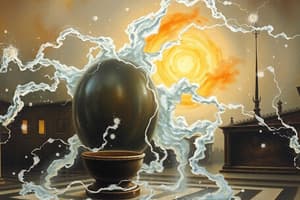Podcast
Questions and Answers
What happens to an object when a force acts upon it?
What happens to an object when a force acts upon it?
- The object may remain at rest without any change. (correct)
- The object will always experience an increase in speed.
- The object will always change its state of motion.
- The object must start moving immediately.
Which of the following is an example of a contact force?
Which of the following is an example of a contact force?
- Electrical force
- Frictional force (correct)
- Gravitational force
- Magnetic force
Which statement best describes a characteristic of force?
Which statement best describes a characteristic of force?
- Force can only stop a moving body.
- Force only exists without an interaction.
- Force is a scalar quantity with no direction.
- Force can change the shape and size of a body. (correct)
What is the standard metric unit for measuring force?
What is the standard metric unit for measuring force?
According to Newton's second law, how is force defined?
According to Newton's second law, how is force defined?
Which of the following effects can a force NOT produce?
Which of the following effects can a force NOT produce?
What distinguishes action at a distance forces from contact forces?
What distinguishes action at a distance forces from contact forces?
In the equation F = ma, what does 'm' represent?
In the equation F = ma, what does 'm' represent?
Flashcards
Force
Force
An interaction between two objects that can change the motion or shape of an object. It can be a push or pull.
Contact Forces
Contact Forces
Forces that require direct contact between objects. Examples include friction, tension, and the force applied by your hand.
Action at a Distance Forces
Action at a Distance Forces
Forces that act on objects without physical contact. Examples include gravity, electricity, and magnetism.
Newton (N)
Newton (N)
Signup and view all the flashcards
Acceleration
Acceleration
Signup and view all the flashcards
Vector Quantity
Vector Quantity
Signup and view all the flashcards
Mass
Mass
Signup and view all the flashcards
Friction
Friction
Signup and view all the flashcards
Study Notes
Introduction to Force
- Force is an interaction between objects
- Force describes the push or pull between objects and their environment
- Force exists when objects interact
- Force does not exist when objects don't interact
The Concept of Force
- Force is an external effect
- Force changes or attempts to change an object's state or direction
- Force produces or tends to produce changes in an object's motion
Effects of Force
- Force can change the state of rest of an object
- Force can change the speed or slow down the speed of a moving object
- Force can change the direction of a moving object
- Force can change the shape and size of an object
Types of Forces
Contact Forces
- These forces happen when two objects interact physically
- Examples include frictional force, tension force, normal force, air resistance force, applied force, and spring force
Action at a Distance Forces (Non-Contact Forces)
- These forces happen when two objects interact without physical contact
- Examples include gravitational force, electrical force, and magnetic force
Measuring Units of Force
- Force and acceleration relationship is discussed using Newton's laws
- When no resultant force acts on an object, it does not move (no acceleration)
- When a resultant force acts on an object, it moves with acceleration
- Force has both magnitude and direction
- The unit for force is Newton (N)
- 1 Newton (N) = 1 kg × m/s² (kilogram times meters per second squared)
Studying That Suits You
Use AI to generate personalized quizzes and flashcards to suit your learning preferences.




